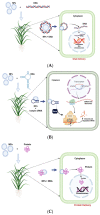Nanotechnological Interventions in Agriculture
- PMID: 35957097
- PMCID: PMC9370753
- DOI: 10.3390/nano12152667
Nanotechnological Interventions in Agriculture
Abstract
Agriculture is an important sector that plays an important role in providing food to both humans and animals. In addition, this sector plays an important role in the world economy. Changes in climatic conditions and biotic and abiotic stresses cause significant damage to agricultural production around the world. Therefore, the development of sustainable agricultural techniques is becoming increasingly important keeping in view the growing population and its demands. Nanotechnology provides important tools to different industrial sectors, and nowadays, the use of nanotechnology is focused on achieving a sustainable agricultural system. Great attention has been given to the development and optimization of nanomaterials and their application in the agriculture sector to improve plant growth and development, plant health and protection and overall performance in terms of morphological and physiological activities. The present communication provides up-to-date information on nanotechnological interventions in the agriculture sector. The present review deals with nanoparticles, their types and the role of nanotechnology in plant growth, development, pathogen detection and crop protection, its role in the delivery of genetic material, plant growth regulators and agrochemicals and its role in genetic engineering. Moreover, the role of nanotechnology in stress management is also discussed. Our aim in this review is to aid researchers to learn quickly how to use plant nanotechnology for improving agricultural production.
Keywords: abiotic stress; nanomaterials; nanoparticles; nanotechnology; sustainable agriculture.
Conflict of interest statement
The authors declare no conflict of interest.
Figures









Similar articles
-
Nanotechnological interventions for plant health improvement and sustainable agriculture.3 Biotech. 2020 Apr;10(4):168. doi: 10.1007/s13205-020-2152-3. Epub 2020 Mar 14. 3 Biotech. 2020. PMID: 32206502 Free PMC article. Review.
-
Biogenic nanoparticles and its application in crop protection against abiotic stress: A new dimension in agri-nanotechnology.Sci Total Environ. 2025 Jan 1;958:177884. doi: 10.1016/j.scitotenv.2024.177884. Epub 2024 Dec 7. Sci Total Environ. 2025. PMID: 39647194 Review.
-
Biosynthesized metal oxide nanoparticles for sustainable agriculture: next-generation nanotechnology for crop production, protection and management.Nanoscale. 2022 Oct 6;14(38):13950-13989. doi: 10.1039/d2nr03944c. Nanoscale. 2022. PMID: 36124943 Review.
-
Sustainable control strategies for plant protection and food packaging sectors by natural substances and novel nanotechnological approaches.J Sci Food Agric. 2019 Feb;99(3):986-1000. doi: 10.1002/jsfa.9341. Epub 2018 Oct 11. J Sci Food Agric. 2019. PMID: 30191564 Review.
-
Nanotechnology for sustainable agro-food systems: The need and role of nanoparticles in protecting plants and improving crop productivity.Plant Physiol Biochem. 2023 Jan;194:533-549. doi: 10.1016/j.plaphy.2022.12.004. Epub 2022 Dec 9. Plant Physiol Biochem. 2023. PMID: 36521290 Review.
Cited by
-
Can nanotechnology and genomics innovations trigger agricultural revolution and sustainable development?Funct Integr Genomics. 2024 Nov 16;24(6):216. doi: 10.1007/s10142-024-01485-x. Funct Integr Genomics. 2024. PMID: 39549144 Free PMC article. Review.
-
The legacy of endophytes for the formation of bioactive agents, pigments, biofertilizers, nanoparticles and bioremediation of environment.World J Microbiol Biotechnol. 2025 Jan 28;41(2):52. doi: 10.1007/s11274-025-04265-2. World J Microbiol Biotechnol. 2025. PMID: 39871057 Review.
-
Mycosynthesis of Silica Nanoparticles Using Aspergillus niger: Control of Alternaria solani Causing Early Blight Disease, Induction of Innate Immunity and Reducing of Oxidative Stress in Eggplant.Antioxidants (Basel). 2022 Nov 24;11(12):2323. doi: 10.3390/antiox11122323. Antioxidants (Basel). 2022. PMID: 36552531 Free PMC article.
-
Enhancing plant resilience: Nanotech solutions for sustainable agriculture.Heliyon. 2024 Nov 30;10(23):e40735. doi: 10.1016/j.heliyon.2024.e40735. eCollection 2024 Dec 15. Heliyon. 2024. PMID: 39717575 Free PMC article. Review.
-
Special Issue Physiological and Molecular Responses of Plants to Engineered Nanomaterials.Nanomaterials (Basel). 2024 Jan 10;14(2):151. doi: 10.3390/nano14020151. Nanomaterials (Basel). 2024. PMID: 38251116 Free PMC article.
References
-
- United Nations, Department of Economic and Social Affairs, Population Division . World Population Prospects 2019: Highlights (ST/ESA/SER.A/423) Department of Economic and Social Affairs, Population Division; New York, NY, USA: 2019.
-
- Food and Agricultural Organization (FAO) The State of Food and Agriculture: Moving Forward on Food and Waste Reduction. Food and Agricultural Organization (FAO); Rome, Italy: 2019. License: CC BY-NC-SA 3.0 IGO.
-
- Faraji J., Sepehri A. Exogenous nitric oxide improves the protective effects of TiO2 nanoparticles on growth, antioxidant system, and photosynthetic performance of wheat seedlings under drought stress. J. Soil. Sci. Plant Nutr. 2020;20:703–714. doi: 10.1007/s42729-019-00158-0. - DOI
Publication types
Grants and funding
LinkOut - more resources
Full Text Sources

